Table of Contents
- TELLURIDES IN GOLD ORES
- Where to look for Native Gold
- PANNING FOR GOLD IN AUSTRALIA
- Gold Panning in Victoria
- Panning for Gold in New South Wales
- Panning for Gold in Queensland
- Panning for Gold in West Australia
- Panning for Gold in New Zealand
- Gold Panning in New Guinea
- Gold Panning in ASIA
- Panning for Gold in India
- Panning for Gold in SOUTH AFRICA
- Panning for Gold in AMERICA
- Panning for Gold in Canada
- Panning for Gold in Nova Scotia
- Panning for Gold in British Columbia
- Panning for Gold in California
- Panning for Gold in Colorado
- Speed Gold Panning Technique
Panning for Gold allows you to detect free or native gold in a piece of specimen rock, in sand or gravel, the sample should be carefully examined by means of a magnifying glass, if the eye is insufficient. The particles of gold, if present in the free state, will probably be distinct, whether wet or dry, and can easily be distinguished by an expert from discoloured mica, iron, or copper pyrites. The usual colour of the metal is well known : but it must be borne in mind that in some localities, such as in New South Wales, Australia, and Costa Rica, it is often found of a very light colour; indeed, sometimes it looks like not very yellow iron pyrites. Gold presents the same colour from whatever direction it is looked at. To the prospector this is a guiding test. If a gold grain be detached from a rock, or selected from sand or gravel, it can be flattened out by hammering and can be cut in slices, whereas those substances likely to be mistaken for gold are reduced to powder when pounded. Iron pyrites is too hard to be cut by a knife, while copper pyrites affords a greenish powder. Besides, pyrites ore, when heated, gives off a sulphury odour. Mica, which when discoloured may be frequently mistaken for gold, is not sectile, and has a colourless streak; it can thus be distinguished from the precious metal. It may be well, too, to know that a speck of gold is not altered in colour or appearance by hydrochloric acid. As the quantity of gold in rock is usually very small—and to be payable it need not be otherwise— the most and only accurate way of determining its quantity is by means of scorification or fusion in a crucible, and afterwards by the cupellation process. This, however, is not always practicable in an out-of-the way place, and, consequently, more simple means are generally sought for by prospectors in order to obtain a rough assay; and as gold is usually, though not always, met with in the pure metallic state, such are to be in a great measure depended upon. At the same time, it must be remembered that frequently the gold occurs as a very fine powder, invisible to the eye or even under a magnifying lens, and also that the grains— probably due to sulphur of arsenic—may be coated with a film, which prevents them from being recognised, and also from being capable of amalgamation with mercury until they have been roasted or undergone some operation. We recently updated our list of the best gold panning kits that you can buy easily from the United States.
To “pan out” gold-bearing matter, the gravel, sand (or rock powdered but not too finely), is placed in a flat bottomed basin or pan, the diameter of which is about a foot, and two or three inches wider at the top than at the bottom. The pan, three-quarters full of ore, should be placed at an inclined position under water, or else water poured into it, and by shaking and agitating the contents of the pan by a kind of oscillatory motion, the lighter portions of the ore are allowed to run over the side of the vessel, until, after much washing, the heavier particles, such as gold, iron sand, &c., settle at the bottom. The iron sand, if magnetic, can be separated from the yellow metal by a magnet, or else can, when dry, be blown away by a gentle blast of air. In Brazil a wooden vessel (a “ batea ’’) serves for the “ pan.” A little preliminary practice in “ panning out ” will be of use to anyone who anticipates actual work.
Place some powdered lead (or copper or iron pyrites) with a good quantity of gravel or sand. Wash the whole with water so that all soluble or easily suspended matter may be got rid of, and thereby the separations may be more clearly observed. Now fill the pan with a fresh supply of water, and shake the whole round about, and chiefly from side to side several times, to allow the heavier matter to settle down (and out of view) underneath the gravel. By tilting the pan a little away from the body, and still shaking it, the lead will still seek the lowest level, and the water may be made to wash some of the gravel over the rim (Fig. 35). By several repetitions of these processes a skilful operator will be able to get rid of all the matter except the lead.
Supposing, however, that the beginner lacks the proper adroitness, or is afraid of washing away the lead, he need not carry the operation so far. But if, towards the last stage, he finds a small quantity of, though sufficient, gravel to entirely conceal the presence of the metal, then, by tilting the pan to one side and away from the body, and allowing the little water to flow a few times in one direction round the bottom of the pan and over the gravel, some of the gravel will be washed along with the water, and the metallic matter will remain behind (Fig. 36). If such trials are successful with copper (s. g. 8·75) and lead (s. g. 11·35), they certainly would be with gold (s. g. 19·35).
When the gold is of so fine a nature as to float, the operator should pour water on the floating particles, so that their upper surface would no longer be dry ; thus some of the gold might sink to the bottom of the “ pan.”
The following is another method of obtaining the free gold from a quantity of ore ; and it may be noted that the surface quartz with iron or other stains (which signify sulphides deeper down the lodes) may be tried for gold by the amalgamation process.
Finely powder a quantity of ore along with water. Add mercury, at the rate of about 1 o z of mercury to 8 lbs. of ore, and, if obtainable, a little cyanide of potassium. Grind the whole for two or three hours until the gold and mercury thoroughly amalgamate. Add water, and when the amalgam has settled at the bottom of the vessel pour the lighter matter off, collect the amalgam and squeeze it through chamois leather. The residue must be heated to drive off any mercury remaining, or i the amalgam be treated with nitric acid, the mercury will be dissolved and the gold left.
An addition of a little sodium will assist the amalgamation and prevent loss due to “ flouring.” Sometimes as much as 30 per cent, of what ought to be the proper yield is lost in the tailings in a free milling ore.
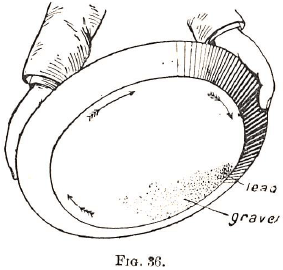
On alluvial diggings, the operation of washing the gold dirt is usually conducted by means of sluices, having an inclination of a very slight gradient. These sluices consist of a series of troughs formed by planks nailed together, the length of each being about 10 or 12 feet, the height 8 inches to 2 feet, the width 1 to 4 feet. By making one end of the bottom plank of each trough 4 inches narrower than at the other, the troughs can be telescoped into one another, and so a sluice of very great length can be formed. Across the inside of the bottom planks small narrow strips of wood, 2 inches or so thick, and 3 or more inches wide, are fixed across, or sometimes at angles of 45° to the side of the trough, at short intervals apart. Running water washes downwards the earth thrown into the sluice, which is open on the top side, and the gold dust accumulates (sometimes assisted by the aid of mercury allowed to trickle out of a vessel from riffle to riffle) in front of the bars, while the lighter matter is washed downwards.
TELLURIDES IN GOLD ORES
The tellurides have usually a light grey colour, though some are dark grey and some have a slightly yellowish tint, are usually brittle (though one is sectile), and sometimes scaly, or film-like; and all have a metallic appearance. The specific gravity of the most valuable is high, viz. : 7 to 10. Most can be scratched by the nail, and all by a copper coin.
Before the blowpipe, a brilliant greenish-blue luminosity is distinctly seen near the test-piece. When boiled in sulphuric acid, a telluride imparts a pinkish colour to the liquid, which becomes greyish if water be added afterwards. A telluride can usually be soon fused to a globule.
Where to look for Native Gold
Found as grains; laminae, sometimes threadlike; nuggets, etc. There is always a small amount of silver in the gold (sometimes, as in California, nearly 10 per cent.), and frequently other metals. Colour—yellow. H.—2·5 to 3; S.G.—12 to 20.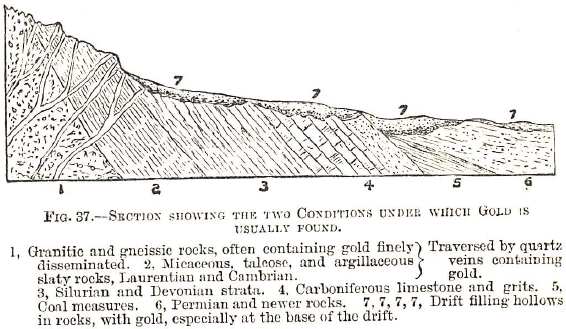
With carbonate of soda or charcoal before B.F. it yields a yellow bead, easily hammered out or cut. If the powdered ore be dissolved in aqua regia (4 parts hydrochloric and 1 part nitric acid), a purple precipitate will be formed, when protochloride of tin is added to the solution ; or a dark brown powder (really pure gold) will be precipitated when a solution of sulphate of iron (copperas) is added.
Gold, nearly invariably in a native State, is very widely distributed over the globe, and is obtained from the gravel, sand, clay, “drift beds,” washed down from gold-bearing strata (sometimes the rich part of the deposits has brown ferruginous matter associated with it), or else from quartz lodes traversing the older slaty and metamorphic rocks and less abundantly in granite. It is also found scattered about in rocks of a granular nature. The ordinary gold-bearing lodes and deposits occur as represented in Fig. 37, which represents the structure of the Ural Mountains. Iron pyrites, copper pyrites, magnetic iron, blende, galena, &c., are some of the metallic minerals often very commonly associated with gold in a lode, the iron pyrites in veins of a gold bearing district nearly, if not always, containing a certain amount of the precious metal. On the surface of a lode the gold specks may perchance be noticed, by the eye or lens, in the cavities of the brown honeycombed quartz rock, although free gold may be invisible in the pyrites rock deeper in the lode and unexposed to atmospheric and other changes affecting the surface portions.
Taking for granted that gold is found under the usual circumstances heretofore mentioned, one must remember it has been payably obtained in unexpected ways : for example, in sinter, in trachyte, in very peculiar conglomerates, &c. Usually the discovery of alluvial gold leads to that of lodes in the neighbourhood; but because gold deposits are not found, it does not follow that the country is non-auriferous. So, too, because gold is not noticed in the outcrop of a lodo, it does not follow that the lode is necessarily an unprofitable one.
It would be out of place here to discuss the theory of how gold in veins was originally formed. In alluvial deposits the grains are usually worn into shape, and so in some other deposits. But it may be remarked that in certain conglomerates the gold is found in thin plates, a fact which suggests that the law of gravity does not apply to the distribution of the metal in these as it usually does in most deposits where the portions nearest the bed-rock are richest. Here, too, it may be mentioned that in conglomerates, such as the South African, the gold is not chiefly in the pebbles, but in the matter which binds them together.
Nearly every country in Europe has yielded gold under the usual circumstances, in deposits and veins in rocks older than the carboniferous formations, in metamorphic rocks, &c.
The precious metal has been found—not generally very lucratively—in the muds and sands of such rivers as the Danube, Elbe, Oder, Weser, Rhine, and in many of the lesser rivers, and consequently some parts of the hill districts through which they pass contain auriferous rocks. Austro- Hungary is rich in lodes (the gold being sometimes found as a telluride), and the extent of the gold-bearing alluvial deposits of the Ural Mountains is enormous. (See Fig. 37.)
In the British Isles gold is found in various parts of Scotland, in Ireland, in Cornwall, Devon, Lancashire, and more especially in Wales. In North Wales not only has it been gathered from the beds of rivers and sand on the seashore, but has been and also is being obtained from lodes (one of which was worked by the Romans). The auriferous quartz reefs (carrying iron pyrites, galena, &c.) run through slates of the old fossiliferous rocks (Lower and Upper Cambrian), and at the intersection of these gold-bearing lodes with other copper and silver bearing ones the reefs are sometimes rich.
The Western States and territories of North America (especially California), some of the Southern States of North America, Canada, Nova Scotia, British Columbia, Central America, Chili, Venezuela, Brazil (some of the mines have for ages back been worked very lucratively), Australia (Queensland, Tasmania, South Australia, Western Australia, New South Wales, and especially Victoria), New Zealand, West Coast of Africa, South Africa, India, &c., Borneo, New Guinea, Philippine Islands, Ceylon, Madagascar, Persia, and others unmentioned, are all gold-bearing countries.
Some of the conditions in which gold is met with in a few of the leading places are herewith given.
PANNING FOR GOLD IN AUSTRALIA
Gold Panning in Victoria
In quartz reefs, mostly through lower Silurian rocks, and a lesser number through Upper Silurian. The direction of the majority of the first set is W. of N., that of the remainder E. of N. Not only have the ordinary alluvial deposits, as generally found near the surface in drifts washed down from the gold-bearing lodes in the higher land, being extremely rich, but also (as in some parts of California) the beds of ancient streams which have been covered by other aqueous deposits over which lava once flowed. The following diagram will exemplify the position of such a rich “gutter ”:—
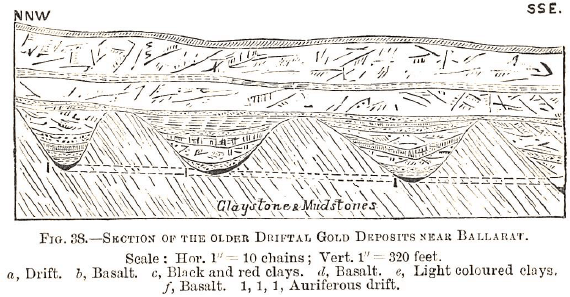
The saddle reefs of Bendigo lie between such strata as sandstone and sandstone, or sandstone and slate; and are met with chiefly at anticlinals, tapering out in depth.
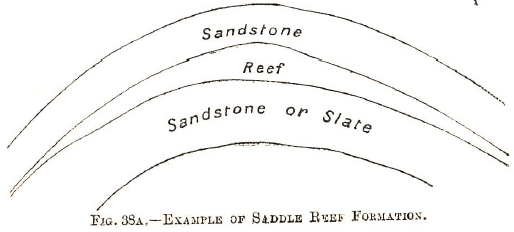
Panning for Gold in New South Wales
In lodes through Silurian, Devonian, and Carboniferous rocks. In lodes at junction of diorite and serpentine; also through diabasic rocks. In sandstone, conglomerates.
Panning for Gold in Queensland
In quartz veins, mostly through metamorphic rocks, though sometimes through granite and syenite, and in alluvial deposits derived from these. At Mount Morgan the auriferous deposit has probably been the result of a geyser, the gold being contained in a siliceous sinter. In some parts the matrix is aluminous ; in others, ironstone predominates. Also in lodes through diorite.
Panning for Gold in West Australia
In ordinary lodes or compound lodes in diorite (notably in Coolgardie district), in diabase, in diorite schist, micaceous schist, chlorite schist, hornblende schist, talcose schist, granite, slate, shale, kaolin, serpentine, &c. In some places the lodes are interbedded with schists. The country rock of the Black Flag district is hard felsite, porphyry, &c.
At the Great Boulder the gold-bearing rock contains a mixture of quartzose ironstone, felspathic material, &c. The veins run through hornblendic and diorite schist. Gold is found at Hannan’s in diabase dykes, &c. Rich tellurides are frequently found in depth.
At Nullagine, in the north-west, there are gold-bearing conglomerates (also diamondiferous) somewhat similar to the “ banket ” of the Transvaal.
Of some of the minerals in which gold occurs unexpectedly may be mentioned jasper, graphite, quartz crystals, chrysoprase. It is also found in sinter, felsparporphyry, &c., and also disseminated in schist, granite.
Panning for Gold in New Zealand
In beds of rivers, in valley bottoms, and on flat land as a deposit, sometimes in a conglomerate formation, along the seashore mixed with magnetic iron, in glacial drifts. In quartz veins through metamorphic rocks, also through andesite.
Gold Panning in New Guinea
In auriferous black sand. In a deposit of decomposed slate, quartz rock, and conglomerate, above which are leaf-bearing clays.
Gold Panning in ASIA
Panning for Gold in India
Gold is found in a very great many different localities, and both in veins and alluvial deposits. In the Wynaad are gold-bearing reefs running through granitic and metamorphic rocks.
Ceylon.—In veins through chloritic and micaceous rocks.
Panning for Gold in SOUTH AFRICA
Gold Panning in Lydenberg
In fissure veins ; in seams of quartz and crystalline conglomerate between beds of shales, sandstones, and schists.
Gold Panning in De Kaap Valley
In fissure veins ; in nearly vertical beds of quartz and quartzite (sometimes carrying sulphides) between layers of schists and shales.
Gold Panning in Witwatersrand
Chiefly in quartz conglomerate. Quartzite separates the reefs in the main reef series. The conglomerate (“banket”) consists of whitish or greyish quartz pebbles cemented together by irony quartzose matter in which is the gold; sometimes the gold is met with as a film on the outside of the pebbles. In some of the other reefs the quartz pebbles are of various colours. As depth is gained, instead of metallic oxides, sulphides are found. Some of the gold is found as crystals.
The “ banket ” conglomerates are newer than the schists and shales with compact quartzite (some of which, however, are gold-bearing) occurring in many districts. In West Africa there are formations like those in the Transvaal.
Elsewhere are reefs in granite, gneiss, slates, &c.
The Main Reef series crops out at Johannesburg. Half a mile or so south is the Bird Reef series. Another mile further south is the Kimberley Reef series. Two miles beyond is the Elsburg series (seven reefs). All these are stratified with quartzites.
Beyond there are 1½- miles of basaltic rock, then quartzites with the Black Reef, which is nearly flat, while the reefs of the former series dip from 40° to 80° South, the strike being nearly E. and W.
At the outcrops the conglomerate pebbles are not so compactly cemented together as those deeper down, and have a reddish brown colour on the outside and in the cementing material.
In depth tho conglomerate is usually greyish, and in the hard siliceous cement small crystals of iron pyrites are scattered about.
Manica and Mashonaland.—Quartz lodes in diorite, schists, granito, &c. Gold is sometimes found scattered about in diorite.
Panning for Gold in AMERICA
Panning for Gold in Canada
In alluvial deposits above talcose and other schists ; in lodes through granite, schists. In fahl-bands, &c.
In Ontario the gold-bearing veins are usually in Huronian (pre-Cambrian) country rock. In some places the gold is found disseminated through schist, porphyry, &c.
Panning for Gold in Nova Scotia
In quartz lodes through serpentine ; in saddle reefs, not unlike those in Australia.
Panning for Gold in British Columbia
Lodes in diorite, between dykes and diorite. So, too, British Columbia offers a large field for prospecting ; also many yet unexplored parts of Africa south of the equator. The Rand “ banket ” deposit, so especially rich in the precious metals, is known to be of very great extent, and other valuable conglomerates may yet be discovered in other regions, though perhaps not noticeably continuous with these. When once the real origin of the gold—sometimes found in crystals—in the “ banket ” is really known, attention may be perhaps paid to various localities in various parts of the world where like natural processes may have taken place in depositing the gold. The very ocean contains—how uniformly is difficult to assert—gold in solution ; and if it has done so in the past ages, one need not be astonished to know that in certain places where, for instance, the salt water has been evaporated, or where nature’s precipitants—not, of necessity, like those employed in the laboratory—have thrown down the metal from its solution, gold fields, yet to be worked, may exist.
Panning for Gold in California
In extensive alluvial deposits at the base of the Sierra Nevada, in the beds of modern and ancient streams, in magnetic iron sand, in lodes through granite, gneissic and other metamorphic rocks, in seam diggings of decomposed bed-rock with irregular seams of auriferous quartz. (Fig. 1) In Placer county the lodes running E. and W., also N. and S., traverse syenite, also metamorphic slate. In Nevada county certain lodes run N.W., and also N.E., the country rock being granite, greenstone, and slate ; generally speaking, the lodes run through metamorphic schists, or greenstone, alternating with belts of syenite.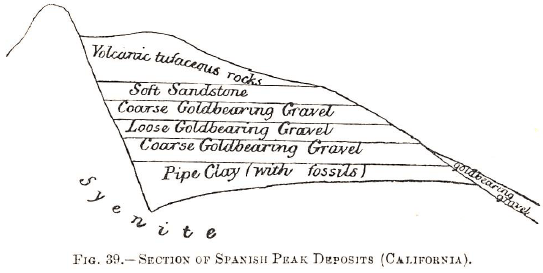
Panning for Gold in Colorado
In the Rocky Mountain regions (Colorado, Montana, Dakota, New Mexico) placers and auriferous lodes are plentiful. As a rule the lodes run through granitie rocks and metamorphic schists and slates, gneiss and quartzite, the gold being associated with iron pyrites, galena, blende, silver ore, &c. So, too, elsewhere in North America. Gold is sometimes found as a telluride (in Colorado, &c.), at Boulder in lodes through micaceous schists, gneissic granite, &c., between granite and porphyry. Also in West Australia, New Zealand, Transylvania, Hungary.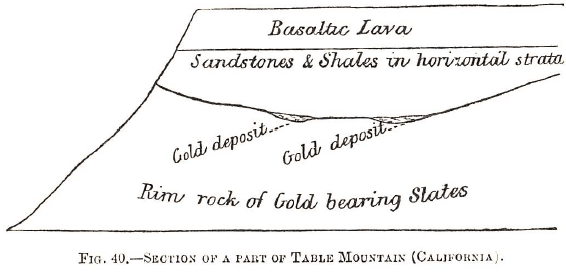
At Cripple Creek, Colorado, some lodes run through andesite. At Telluride, Colorado, some gold and silver- bearing veins are in rhyolite, augite-andesite, andesite breccia, &c.
At Silver Cliff, Colorado (Bassick Mine), zones of various sulphides surround pieces of country rock, and carry silver and gold, Tellurides, too, occur.
In Utah, in one district, the precious metal is associated with cinnabar in a formation through limestone.
In British Guiana, in the neighbourhood of some of the alluvial diggings, the country rocks are chiefly granitic, syenitic and metamorphic. Eruptive dykes are plentiful.
As mentioned in the introduction to this book, the prospector should not necessarily confine his explorations to any particular district in an auriferous country. For instance, in Western Australia there must be large tracts of land which merit a systematic examination, notwithstanding that at the present time there are gold-bearing areas in the north (Kimberley), in the north-east (Pilbarra and Ashburton), in the east (Murchison), and in the south (Yilgarn, Coolgardie, and Dundas).
Suffice it to remark, gold seems to be very much distributed throughout the world ; and consequently the prospector should keep his eyes open wherever he goes and get rid of the notion that good specimens of gold in lode, quartz, or alluvial deposits are the only desiderata so far as he is concerned in his searchings.
In many mines, where labour, &c., is cheap, and the quantity of ore great, a few pennyweights of gold to the ton will pay to extract, and even in a mine where the ore yields averagely nearly 1½- oz. per ton, the amount of gold in bulk is very small compared to that of quartz (say equal to 5 sovereigns in 14 or 15 cubic feet of quartz). Thus it really matters little whether the specks of gold are visible to the naked eye or distributed in a very finely divided State throughout the mass, so long as it is recoverable by some of the many methods now in use, and of course likely to be improved upon in the future.
Speed Gold Panning Technique
As a Gold Panning Method, this is very impressive (to me anyway).
Speed Gold Panning Method does not fail him.
Beginning’s instruction and basic method.
